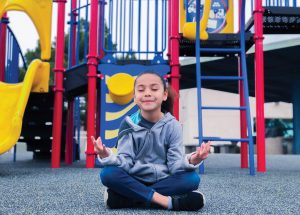 You are reading right now. You are facing this page and your eyes are gazing at these letters and these… There is nothing inherently fantastic about this moment, but because I’ve engaged a bit of intentional situation awareness, reading seems to have more character.
You are reading right now. You are facing this page and your eyes are gazing at these letters and these… There is nothing inherently fantastic about this moment, but because I’ve engaged a bit of intentional situation awareness, reading seems to have more character.
Let’s continue. Feel your feet in your socks, on the ground. Become aware of your breath, its simplicity and its flow. Feel the texture of the page. Capture the tones of colors in your periphery. Tune in to the sounds and squeaks of the environment around you. You are enlivening your senses until your mind is full. You are being mindful.
What isn’t mindfulness?
You’ve certainly seen the image on magazines. An attractive person in yoga clothes tucked away neatly into a protective cocoon of a glowing halo, safely guarded from bills, taxes, teenagers and flash floods. This is not mindfulness. This is escapism.
What is mindfulness?
Mindfulness, by its nature, is reality-based. Did you come home and notice that the dishes you had asked your teenage child to clean and put away were still there—in the sink. With more dishes added audaciously? Mindfulness isn’t escaping to your happy place. It is recognizing the valid frustration attendant to this experience but not letting that frustration make the situation worse. While there are a million articles, each with millions of components to being mindful, we have narrowed them down to four essential mindfulness skills.
- Observing the Environment—Mindfulness is about observing your environment like a video camera, engaging in wordless watching. Merely notice the body sensations but do not respond to the action urges. If you feel an itch or pain, simply notice it. You can even tell yourself, sensing. Observing the environment means paying attention on purpose to the present moment. It also means controlling your attention, pushing away nothing and clinging onto nothing.
- Participate with Reality—Completely, wholeheartedly and 100 percent throw yourself into the activities of the current moment. Whatever that may be. Talking to a friend, playing football, even just driving. Become one with whatever you may be doing. Go with the flow.
- Nonjudgmentally—Observe the environment, the events, the emotions, the facts of life, but don’t evaluate them as good or bad. Just the facts, ma’am. This probably is the hardest skill. We humans are judgment machines. We are built to draw conclusions about the world. Resist this natural inclination, and become a video camera. Take in raw data and understand that you are part of the viewfinder. Record your own reactions and thought patterns, but don’t judge them.
- One-mindfully—Humans, by our nature, obsess over the past and worry about the future. It’s a survival mechanism, but it really can take us from savoring the love we have surrounding us when we come home from work. To this end, commit yourself to being only here. Right here. If you find yourself thinking about the past or future, you can just say thinking. Let go of distractions like other action urges or thoughts and come back to what you are doing over and over.
When to Practice Mindfulness
Quite possibly one of the best ways to practice mindfulness is while spending time with your children. And, of course, there are clear benefits for your child, as well. Mindfulness can help your child regulate his own emotions, develop coping skills, even increase his attention span. Mindfulness can decrease screen time and increase enjoyment in a wide variety of activities. Here are some ideas to practice with your children:
- Share a three-breath hug—Hug your child. While hugging, you and your child take three intentional breaths together. Inhale and expand your bellies against each other. Hold at the top for a second. Exhale, dropping your shoulders and relaxing all of your muscles, letting go of all tension in your bodies. Repeat two more times.
- Share your sensations, thoughts and feelings—Have your child share about them, too. Pretend to be like a detective or a doctor, finding out what our brain is telling us. What our body wants us to do. What are we feeling exactly? Sad, or despondent? Angry or annoyed?
- Mindfulness Practice—You also can schedule time to engage in mindfulness practice. Close your eyes and pay attention to your breath. Imagine your thoughts as clouds. Coming and going. Watch them come and go, but don’t latch on to any one thought.
- Name five things that are giving you comfort—Trade off with your child in naming five mundane things that are making you comfortable right now. For me, it’s the taste of Sprite in my mouth, which I can still taste from lunch. It’s comfy socks I chose to wear today. It’s that I am sitting cross-legged at a desk. It’s the slight smile I have while I am typing.
Mindfulness is really the act of savoring each moment, finding a secret indulgence often overlooked. What better time to practice than with the one with whom your time spent feels the most decadent—your children?
Self Development Academy (SDA) is a top-ranked charter school with two locations in Northeast Mesa and Central Phoenix. SDA is opening two new schools for fall of 2019. The locations are in Southeast Mesa and North Phoenix. For more details, please call (480) 641-2640.

